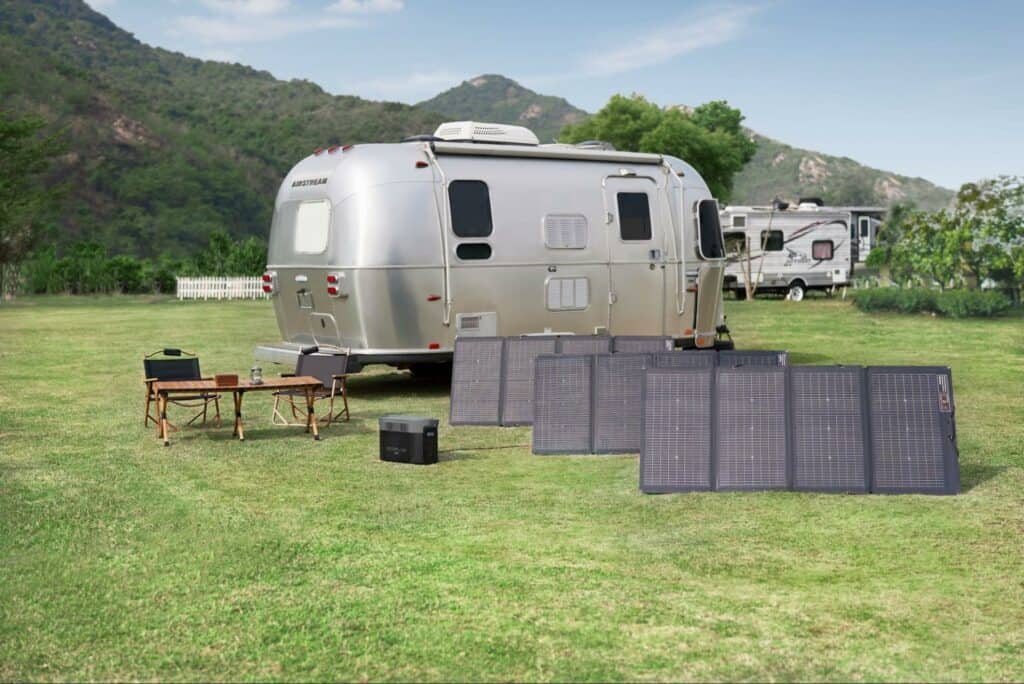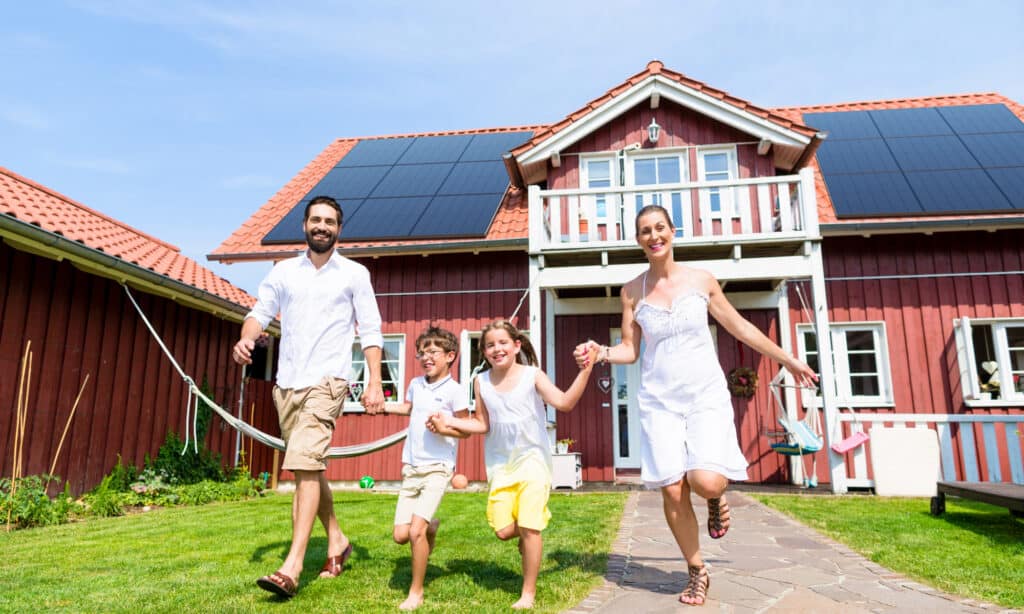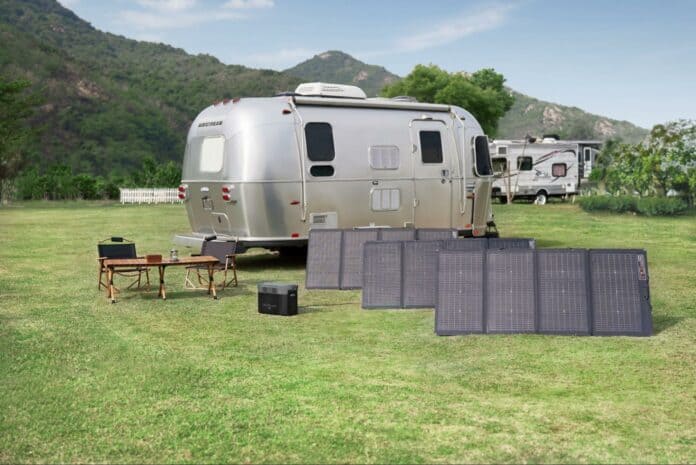Table of Contents
Photovoltaic panels are becoming increasingly popular as we work towards a greener and more sustainable future. Photovoltaics have reduced in price significantly in the last ten years, and surprisingly, their quality has increased exponentially. But some homeowners are still asking themselves, are PV modules worth it?
Today, we’ll explore how PVs work, how much they cost, grants that can save you money, and other potential photovoltaic benefits. By learning their ins and outs, you can determine for yourself if investing in a photovoltaic kit is worth it for you.

What Are Solar Panels
Photovoltaics (PVs), or solar panels, are modules that create clean and green solar energy directly from sunlight.
They come in portable units that work great for off-grid adventures and tiny homes, as well as rigid panels intended for fixed roof or ground-based installations.
There are even flexible PVs designed to fit the curvature of a boat, motorhome roof or other unusual surfaces, allowing you to maximise the amount of energy you can generate.
(Source: Solar Power Guide)
How Do Solar Panels Work?
Solar panels capture photons from sunlight and convert them into DC electricity using the photovoltaic effect.
Most solar panels use monocrystalline or polycrystalline silicon solar cells to gather photons.
Each PV panel contains many solar cells, typically encased in a metal frame under a transparent protective surface, like tempered glass.
When sunlight hits the silicon semiconductors in the photovoltaic module, it’s absorbed by the PV cells.
This frees the cells’ electrons, which start moving in one direction, creating a direct electrical current (DC).
This energy then flows into an inverter, which converts that DC current into the alternating current (AC).
When the inverter is connected to an LFP battery like EcoFlow DELTA Pro, you can use the energy to power your household appliances and electronic devices.
How Much Do Solar Panels Cost?
The cost of your solar power kit depends entirely on the size of your home and your energy needs. These factors will determine how many panels you require and the capacity of the portable power station you need to go with it.
It’s important to understand that you need more than just the photovoltaic modules themselves. The total cost of a residential solar power system will include the photovoltaics, installation fees, and the balance of system. This will include your LFP battery, inverter, wires and cables, controller, and battery management system. If you have a particularly large home or especially high energy demands, you may also need additional batteries, like EcoFlow DELTA Pro Smart Extra Batteries.
Depending on the manufacturer, quality, and rated power, one solar panel can cost you between £150 and £750. Once you factor in how many modules you need and your balance of system, a complete residential kit typically costs between £5,000 and £11,000.
Solar Panel Grants
There are numerous financial incentives for residential solar solutions to help reduce your installation costs. If you install a comprehensive solar power solution like EcoFlow’s Smart Home Ecosystems, you could also qualify for significant tax breaks.
If you live in England, Scotland or Wales, you could benefit from a Smart Export Guarantee (SEG) tariff. The SEG (formerly the Feed-In Tariff) system means you could receive payment for any excess renewable electricity you export back to the electrical grid.
Numerous other grants in the UK can help you get your photovoltaics at a reduced cost or even sometimes for free.
UK Government Solar Incentives (Open to Eligible Applicants in 2024)
| Solar Grants | Run Dates | Eligibility | Potential Savings (If Qualified) |
| Solar Together | N/A | Homeowners and renters residing in participating council areas | 10% – 25% |
| Energy Company Obligation (EC04) | April 2022 – March 2026 | Homes in England, Scotland, or Wales. | Homeowners/residents may be eligible for free solar panels |
| Home Upgrade Scheme (HUG2) | April 2023 to March 2025 | Low-income, off-grid, and low energy efficiency rated properties | Up to £10,000(dependent on your local council) |
| Home Energy Scotland Grant and Loan Schemes | N/A | Homes in Scotland | Up to £6,000 |
| Welsh Government Warm Homes Nest Scheme | N/A | Low-income/low energy performance rated Welsh homes | Homeowners/residents may be eligible for free solar panels |
| Solar Schemes | Run Dates | Eligibility | Potential Savings (If Qualified) |
| Smart Export Guarantee (SEG) | N/A | Households with Microgeneration Certification, export meter, and maximum capacity <5MW | 1p to +/- 25p per kWh, depending on your choice of SEG licensee and agreement terms |
| 0% VAT on Solar Panel Purchases and Installation | April 2022 – March 2027 | Purchase and installation of solar panels | 0% VAT charged on solar panel purchases. O-5% VAT on installation costs. |
The eligibility requirements for these grants will depend on the type of system, your location, your financial status, the energy efficiency of your building, and details about the installation.
Be sure to research those factors thoroughly to make sure you qualify.
What Are Your Potential Savings with Solar Panels?
You can save a lot of money when you install photovoltaics. To determine how much you can save, you first need to understand the solar payback period. This is the amount of time between your initial purchase, including your system and installation fees, and the time when your initial cost is covered by what you’ve saved on reduced or eliminated electricity bills.
For example, if your system costs you £5,000, once you have saved £5,000 on your electricity bills, you have achieved solar payback. For those investors out there, it’s just another way of saying when you will get your return on investment (ROI).
Once you reach your solar payback, everything after that is pure savings. How much you can save depends on where you live, how much electricity you use, and how much that electricity costs. However, the average owner saves between £21,250 and £40,325 over the lifespan of their PVs, a significant sum to put toward other expenses.
Are Solar Panels Worth It in the UK?
Despite the initial investment, photovoltaics are definitely worth buying in the UK. Let’s look at why.
Significant Electricity Bill Savings
Homeowners can save significant sums of money by reducing or even eliminating current electricity bills, with average owners saving anywhere between £21,250 and £40,325 over the lifespan of their PVs.
Energy Security
When you’re no longer dependent on the national grid, you won’t have to worry about extended blackouts or power outages. If the power goes out, your solar panels will continue generating energy and keep your home powered.
Reduce Your Carbon Footprint
With climate change as pressing a notion as ever, you’ll be doing your part when you install photovoltaics. Because solar panels produce clean, renewable energy directly from the sun, there are zero greenhouse gas emissions, allowing you to reduce your carbon footprint significantly.
Increased Property Value
Due to photovoltaics being such an attractive, sustainable, and money-saving option, installing them on your home will increase your property value by an estimated 0.9 – 2% based on 2021 numbers. This figure can be much higher in certain areas and is only expected to rise as we increase our efforts to tackle climate change.
How Many Solar Panels Do I Need to Power My House?
How many PV modules you need to power your house depends entirely on how much electricity you use. If you have a family of four in a large house, you’ll need more solar panels than a single person living in a smaller home.
To work out how many PVs you need, you should look at your annual electricity bill to figure out how many kWh of energy you use in an average year.
In the UK, the average 3-bedroom home uses 2,700 kWh per year. The average solar panel is rated at 350W, which produces an average of 265 kWh of solar energy. Suppose we divide this annual usage by 265. In that case, we receive 10.1, meaning you would ideally require 11 solar panels to power your home year-round or less if you purchased panels with greater capacity, such as EcoFlow’s 400W Rigid Panels.
Factors To Consider Before Switching to Solar
Before switching to solar, there are several factors you need to consider, depending on your home, energy needs, and budget. Let’s take a look.
Initial Cost and Installation Expenses
The cost of your kit will depend on what type of system you are buying, how many photovoltaic panels you need based on your energy consumption, and how much it costs to install. The average cost of a full solar power system in the UK is typically between £5,000 and £11,000, including installation fees.
Solar Panel Grants
If money is a deciding factor, research available grants in your area. Depending on your living and financial situation, you could save significant funds, and your installation, in certain circumstances, could cost nothing. These grants are a fantastic way of saving when looking to install PVs.
Energy Needs and Consumption Patterns
The number of modules and what size solar battery you need will depend entirely on your household energy needs. While 350kWh per month is the average value in the UK, your needs will be greater if you have a large family or a large house. Conversely, if you live alone and have a small house, your energy demands will be lower.
Many homeowners aim to supplement their electricity and avoid paying increased costs during peak hours. Energy companies raise their prices during day time and lower them at night, meaning solar panels save you even more money when you utilise them during the day. With energy costing more than ever, solar energy is an increasingly popular choice.
Longevity
Quality photovoltaics are expected to last from 25 to 35 years. While they can technically last longer, all photovoltaics slowly degrade over time for a number of reasons. As long as your photovoltaics aren’t damaged, the main factor causing degradation is thermal cycling. This is the repetitive expansion and contraction over time, with changes in temperature, that cause microcracks and reduce efficiency. On average, photovoltaics will degrade about 0.5% per year. This means that after 20 years, your array should still work at about 90% capacity.
Efficiency
Not all photovoltaics are created equal.
There are cheaper polycrystalline PVs and slightly more expensive monocrystalline PVs. The difference between the two is in the manufacturing process.
Polycrystalline PVs are made with multiple cells merged together, sacrificing efficiency for a reduction in cost.
When it comes to solar panels, efficiency has a very specific meaning. It measures how much available sunlight photovoltaic solar cells turn into electricity per square meter of PV surface.
Solar panels with a higher efficiency rating produce more electricity from sunlight than PV modules with lower efficiency.
Efficiency is essential to consider when determining how many and which kind of solar panels you will need for your installation.
Monocrystalline cells are made using a single cell, but manufacturing is more expensive.
(Source: ASES)
Given that all PVs degrade over time and installing a new kit is a big decision, spending that little extra and getting a maximum efficiency rating is worth it.
High-quality PVs like EcoFlow’s mountable solar panels boast a 23% efficiency rating, while comparable polycrystalline models are rated at 13 – 16%.

Final Thoughts
Investing in a photovoltaic system is a huge decision for you and your family, so conducting proper research and determining what’s best for your home and your energy needs is vital. Fortunately, the cost of PVs has come down in recent years, and with the constantly rising cost of energy, investing in a solar kit is becoming more and more affordable, even for those on a tight budget.
When you look at all the financial benefits you will gain when you invest in quality solar panels, it will be hard to convince yourself why you shouldn’t do it.







